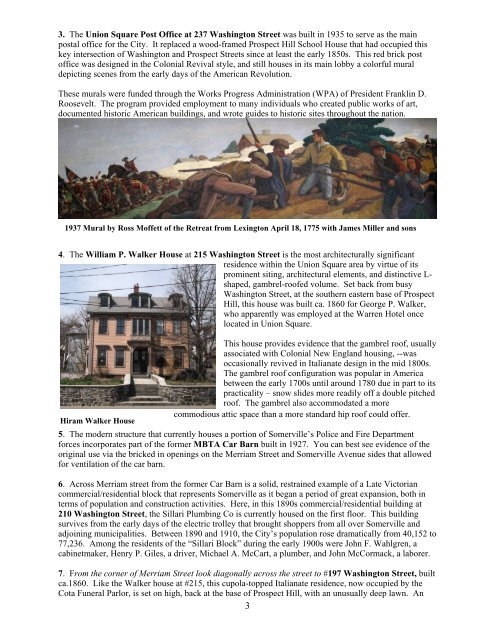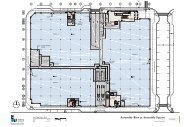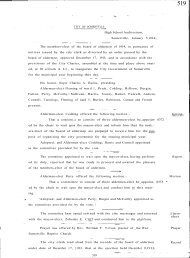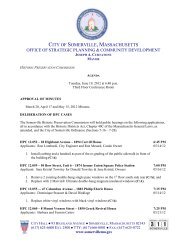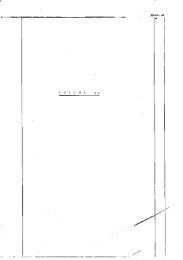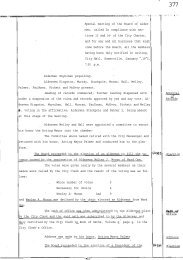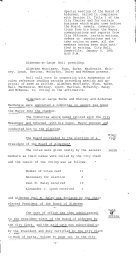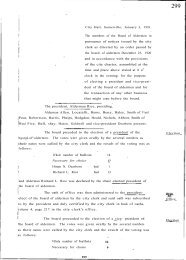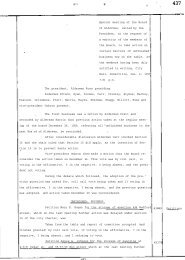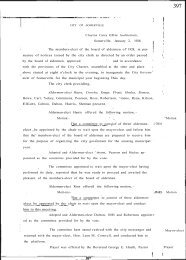Union Square Revisited: From Sand Pit to ... - City of Somerville
Union Square Revisited: From Sand Pit to ... - City of Somerville
Union Square Revisited: From Sand Pit to ... - City of Somerville
Create successful ePaper yourself
Turn your PDF publications into a flip-book with our unique Google optimized e-Paper software.
3. The <strong>Union</strong> <strong>Square</strong> Post Office at 237 Washing<strong>to</strong>n Street was built in 1935 <strong>to</strong> serve as the main<br />
postal <strong>of</strong>fice for the <strong>City</strong>. It replaced a wood-framed Prospect Hill School House that had occupied this<br />
key intersection <strong>of</strong> Washing<strong>to</strong>n and Prospect Streets since at least the early 1850s. This red brick post<br />
<strong>of</strong>fice was designed in the Colonial Revival style, and still houses in its main lobby a colorful mural<br />
depicting scenes from the early days <strong>of</strong> the American Revolution.<br />
These murals were funded through the Works Progress Administration (WPA) <strong>of</strong> President Franklin D.<br />
Roosevelt. The program provided employment <strong>to</strong> many individuals who created public works <strong>of</strong> art,<br />
documented his<strong>to</strong>ric American buildings, and wrote guides <strong>to</strong> his<strong>to</strong>ric sites throughout the nation.<br />
1937 Mural by Ross M<strong>of</strong>fett <strong>of</strong> the Retreat from Lexing<strong>to</strong>n April 18, 1775 with James Miller and sons<br />
4. The William P. Walker House at 215 Washing<strong>to</strong>n Street is the most architecturally significant<br />
residence within the <strong>Union</strong> <strong>Square</strong> area by virtue <strong>of</strong> its<br />
prominent siting, architectural elements, and distinctive Lshaped,<br />
gambrel-ro<strong>of</strong>ed volume. Set back from busy<br />
Washing<strong>to</strong>n Street, at the southern eastern base <strong>of</strong> Prospect<br />
Hill, this house was built ca. 1860 for George P. Walker,<br />
who apparently was employed at the Warren Hotel once<br />
located in <strong>Union</strong> <strong>Square</strong>.<br />
Hiram Walker House<br />
This house provides evidence that the gambrel ro<strong>of</strong>, usually<br />
associated with Colonial New England housing, --was<br />
occasionally revived in Italianate design in the mid 1800s.<br />
The gambrel ro<strong>of</strong> configuration was popular in America<br />
between the early 1700s until around 1780 due in part <strong>to</strong> its<br />
practicality – snow slides more readily <strong>of</strong>f a double pitched<br />
ro<strong>of</strong>. The gambrel also accommodated a more<br />
commodious attic space than a more standard hip ro<strong>of</strong> could <strong>of</strong>fer.<br />
5. The modern structure that currently houses a portion <strong>of</strong> <strong>Somerville</strong>’s Police and Fire Department<br />
forces incorporates part <strong>of</strong> the former MBTA Car Barn built in 1927. You can best see evidence <strong>of</strong> the<br />
original use via the bricked in openings on the Merriam Street and <strong>Somerville</strong> Avenue sides that allowed<br />
for ventilation <strong>of</strong> the car barn.<br />
6. Across Merriam street from the former Car Barn is a solid, restrained example <strong>of</strong> a Late Vic<strong>to</strong>rian<br />
commercial/residential block that represents <strong>Somerville</strong> as it began a period <strong>of</strong> great expansion, both in<br />
terms <strong>of</strong> population and construction activities. Here, in this 1890s commercial/residential building at<br />
210 Washing<strong>to</strong>n Street, the Sillari Plumbing Co is currently housed on the first floor. This building<br />
survives from the early days <strong>of</strong> the electric trolley that brought shoppers from all over <strong>Somerville</strong> and<br />
adjoining municipalities. Between 1890 and 1910, the <strong>City</strong>’s population rose dramatically from 40,152 <strong>to</strong><br />
77,236. Among the residents <strong>of</strong> the “Sillari Block” during the early 1900s were John F. Wahlgren, a<br />
cabinetmaker, Henry P. Giles, a driver, Michael A. McCart, a plumber, and John McCormack, a laborer.<br />
7. <strong>From</strong> the corner <strong>of</strong> Merriam Street look diagonally across the street <strong>to</strong> #197 Washing<strong>to</strong>n Street, built<br />
ca.1860. Like the Walker house at #215, this cupola-<strong>to</strong>pped Italianate residence, now occupied by the<br />
Cota Funeral Parlor, is set on high, back at the base <strong>of</strong> Prospect Hill, with an unusually deep lawn. An<br />
3


